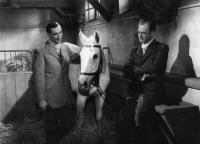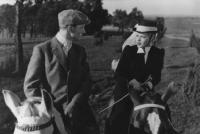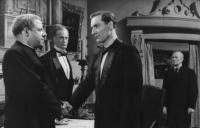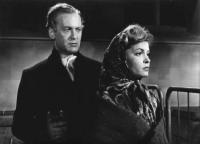Film eye : A German ‘Quiet Man’? Meines Vaters Pferde [My Father’s Horses]
Published in 20th-century / Contemporary History, General, Issue 2 (March/April 2013), Reviews, Volume 21
Prussian cavalry officer Michael Godeysen (Martin Benrath, left) with the film’s main Irish character, Sir John Fitzpatrick St Ives, Baronet of Eryllgobragh, known as ‘Pat’ (Curd Jürgens, right).
No film has dominated the Irish film landscape as much as John Ford’s The Quiet Man, which celebrated the 60th anniversary of its release last year. The worldwide success of Ford’s classic may have also partly inspired the making of a German ‘Quiet Man’, partially set and shot in Ireland and dating from 1953—complete with an outsider arriving in a close-knit Irish rural area, a convoluted triangular romantic narrative, as well as scenes centred upon a horse race involving all of the local community. The movie, Meines Vaters Pferde [My Father’s Horses], was directed by Gerhard Lamprecht and has recently been re-released on DVD in Germany. The filmic fantasies produced in West Germany in the 1950s have usually been interpreted as a reflection of, and a reaction to, the West German ‘economic miracle’ and its accompanying ethos of hard work and social mobility. Many of these escapist movies were set in ‘exotic’ locations, and thus it is not surprising also to find some partly set in an idealised, wild and untamed Ireland.
Meines Vaters Pferde is a two-part melodrama and was released in cinemas to acclaim in West Germany. A large section of part one—Lena and Nicoline—is set in the ‘south of the Green Island’ and was filmed in County Wicklow. It centres on the diaries of Michael Godeysen, concerning events that occurred at the end of the nineteenth century and the early twentieth century, which are read out to his son Fähnrich Godeysen (who has just returned from World War II) in hospital in 1946 by a mysterious (fluent German-speaking) Irish woman. She turns out to be the granddaughter of Fähnrich’s father’s lost Irish love, Nicoline. The movie is based on a popular novel by Clemens Laar, a type of early twentieth-century, aristocratic-conservative Prussian Dick Francis, who specialised in horse-based melodramas and now remains largely forgotten.

The film features a melodramatic love triangle, as Godeysen spends a large amount of time on the country estate with Pat’s wife, Nicoline (Eva Bartok).
The film’s main Irish character, Sir John Fitzpatrick St Ives, Baronet of Eryllgobragh [sic] and known as ‘Pat’, is introduced as Michael Godeysen is serving as a Prussian cavalry officer in 1897 and has just been decorated for winning a military cross-country horse race (against a train!) outside Berlin. The Irish Catholic aristocrat Pat is also then serving as an officer in the Prussian army. Godeysen explains that he had won the race unfairly, although this was not of his doing, and is publicly humiliated—not for winning the race fraudulently but actually for his honesty. Pat, obviously impressed by his integrity, says that he should come to visit him at his Irish stately home. The next extended segment of the movie is set in 1902 in Ireland as Godeysen visits Pat. Thus begins a melodramatic love triangle as Godeysen spends a large amount of time on the country estate with Pat’s wife Nicoline—and her beloved horse Avourneen. Pat engages in brooding emotional intensity as he balances his secret Irish nationalist rebel activities with his daily life, viewing the increasing closeness of Godeysen and Nicoline. Eventually Pat attempts to commit (quasi-)suicide during the local point-to-point race as he rides Avourneen—who does not jump over walls, something that is absolutely necessary for the point-to-point cross-country race. Pat becomes seriously injured, Nicoline remains with him and Godeysen returns to Germany. The emotionally intense Irish nationalist aristocrat Pat is played by Curd Jürgens, one of the biggest German stars of the period. Jürgens is probably best known to an English-speaking audience as the ‘decent German’ U-Boat commander, starring alongside Robert Mitchum, in the Hollywood film The Enemy Below (1957), while he also later featured as the villain Carl Stromberg in the James Bond movie The Spy Who Loved Me (1977), starring Roger Moore.Extremes of weather and intense, wild landscapes dominate the view of Ireland in the movie. The first scene-setting image of the island is of wild sea waves crashing against cliffs, while there are numerous scenes of the characters riding through hills and meadows that appear in a Gothic, almost threatening fashion. The Irish locations are primarily in County Wicklow, and the Sugarloaf Mountain features prominently. There are also a number of violent storms—including one when Godeysen arrives and when Pat is hiding an Irish nationalist rebel on the run.

Godeysen meets the extreme nationalist Fr Quentin (left) for the first time, as Pat and his butler look on. All images: Deutsches Filminstitut.
Extremes of emotionality and alcohol are also evident. Pat is played as an emotionally intense, brooding, Heathcliff-type character, torn between love of his country and love of his wife, from whom he keeps his nationalist activities secret. A large amount of whiskey is consumed throughout the Irish part of the movie and Pat often appears intoxicated—although it is also suggested by Pat that drunkenness is an Irish form of camouflage used to fool their British opponents! Even when meeting Godeysen for the first time in Berlin, Pat orders whiskey from the waiter only to be told that they do not have any and orders champagne instead. An intensity of Irish nationalism and Catholicism is also evident throughout the Irish part of the film; indeed, the intensely nationalist Catholic chaplain of the Eryllgobragh estate neatly combines both elements. As Fr Quentin comes in from a storm he chides Pat for serving ‘English’ (actually Scotch) rather than Irish whiskey, while he sarcastically feels sorry for the ‘British police’ outside in the storm. Pat at one point tells Godeysen that his Irish nationalism is like a poison that could tear him into pieces, but he will not rest until ‘Ireland is free’.

Pat engages in brooding emotional intensity as he views the increasing
closeness of Godeysen and Nicoline.
















